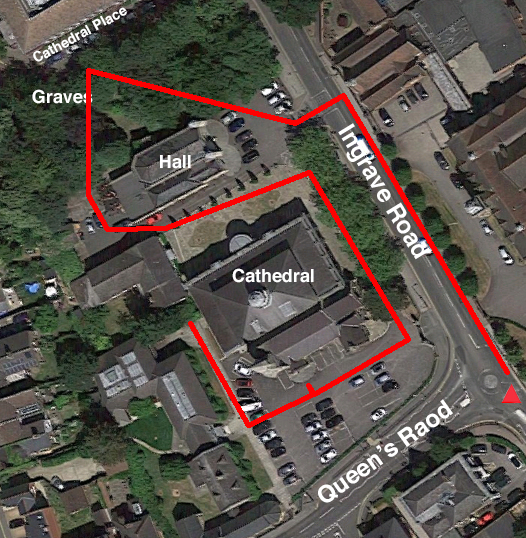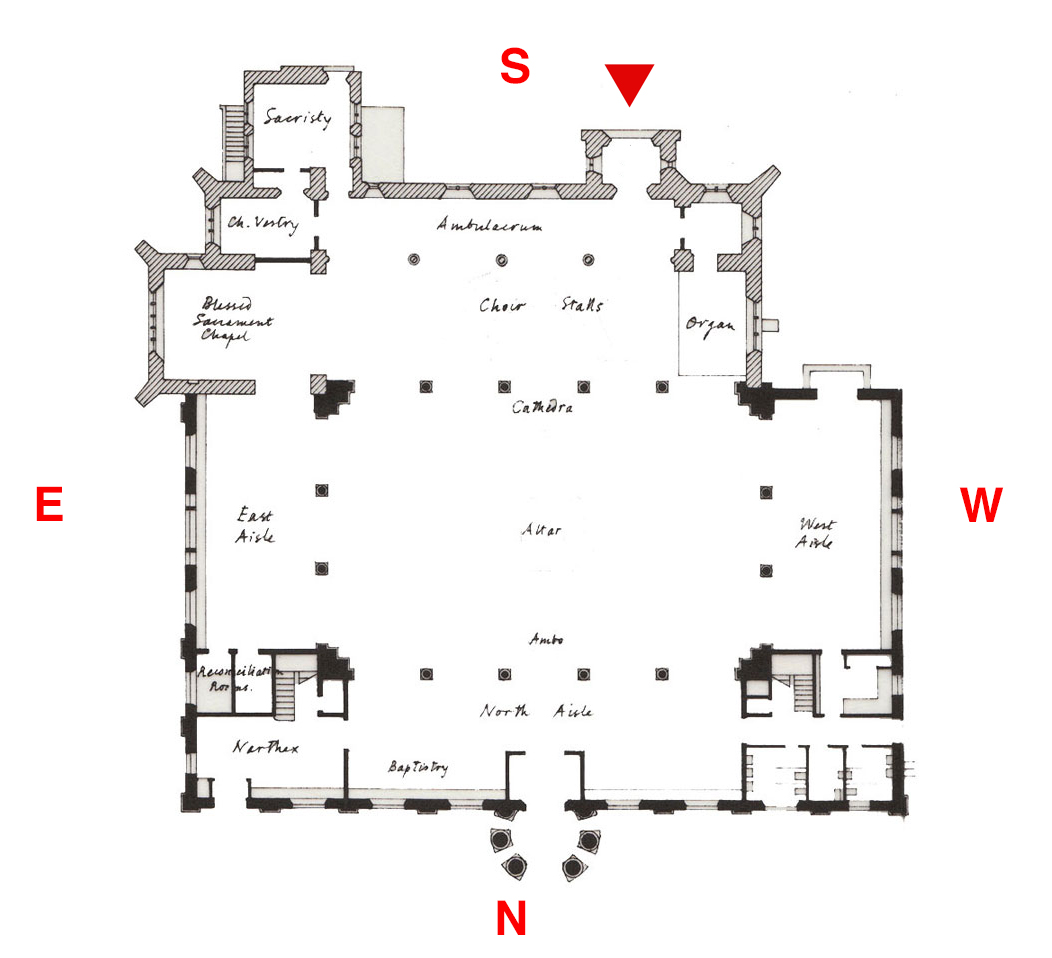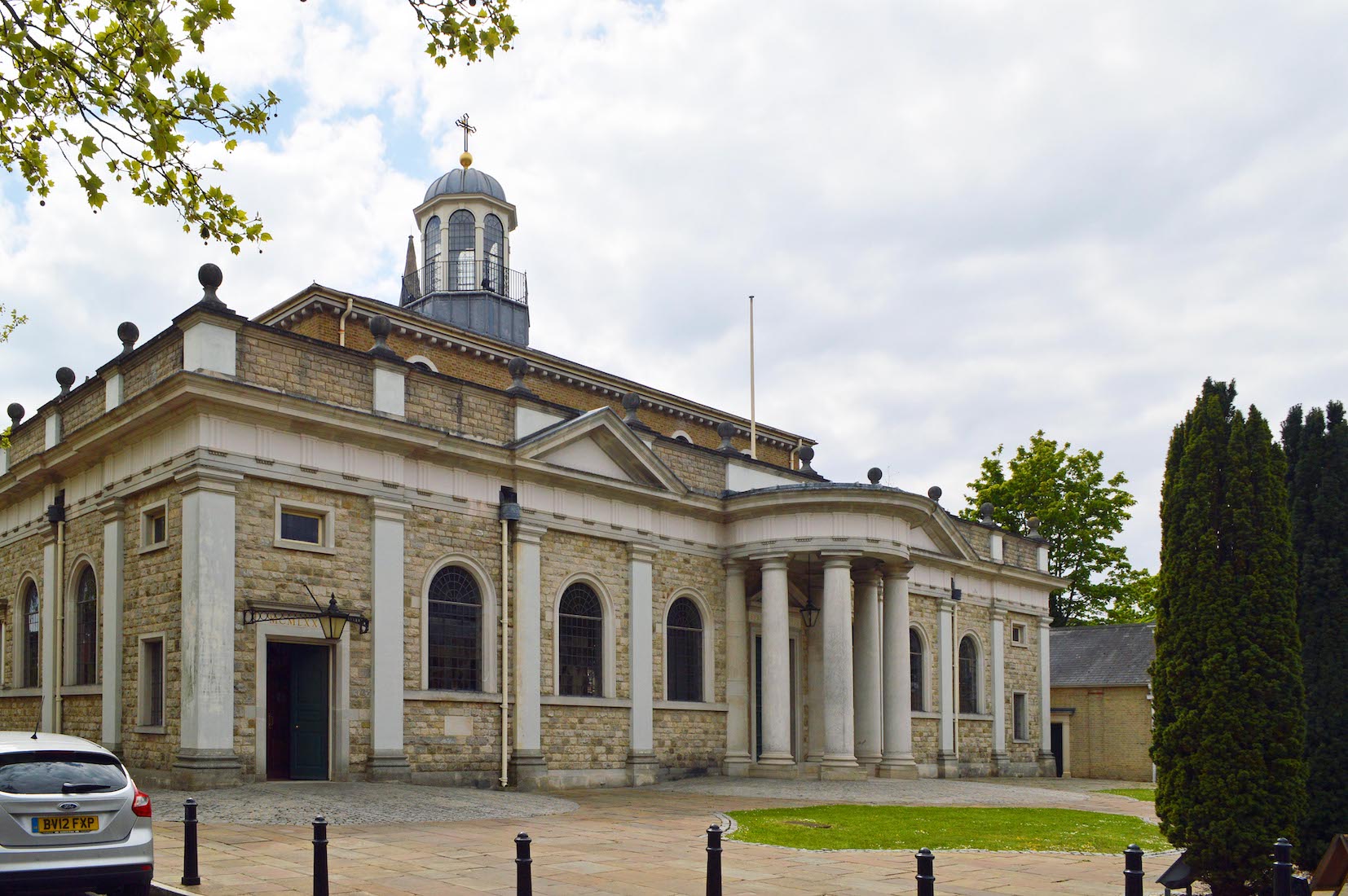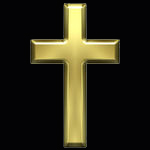BRENTWOOD CATHEDRAL
ENGLAND CATHOLIC
PAUL SCOTT

SATELLITE VIEW
Brentwood Cathedral is sited on the corner of Ingrave Road and Queen’s Road.
The Cathedral itself is an interesting blend of old and new. The original church can be seen at the bottom of this view. It has a tower and an entry door at bottom left. To this has been added a much larger rectangular modern extension which abuts the old church. It has a central lantern, and a semicircular portico to the north. There is also another entrance in the northeast corner.
As well, there is a Cathedral hall, and an old graveyard.
The route of our outdoors exploration is shown in red, starting at the busy road intersection. We then enter off Ingrave Road, take a brief look at the old graveyard, walk past the back of the hall, and then circumnavigate the Cathedral in a clockwise direction. Finally, we enter the old church part of the Cathedral through the south door.
We observe that geographically the Cathedral is s ited at 30° ‘off the square’. For our descriptions here we make the easy transition to the square, taking Ingrave Road to run exactly north-south.

This is the architect’s plan for the Cathedral with the new extension. Perversely, it is printed with a 180° turn! The old church is at the top, and the new extension below. The red letters show the directions we shall use here. They correspond to the architect’s labelling, and also the liturgical orientation of the old church.
[There is a case for the completed Cathedral to have liturgical ‘East’ at the top where the choir, organ and sacristy are, and opposite the ‘West’ door at the bottom. We shall not use this convention.]
In our tour we shall enter through the South door (top), explore the old church, and then the new addition.
You can begin, or access intermediate points in the tour by a tap / click on the following links:
START 01 (begin the tour)
Entry 15 (enter the old church)
New Nave 35 (explore the new addition)
NOTE ON MAGNIFYING IMAGES
With this website format the images are large enough for most purposes. If there is a need for greater magnification of an image, go to the identical photo on
https://www.flickr.com/photos/paulscottinfo/albums
and use Command - + (Mac) or Windows - + (Windows).
HISTORY
[Wikipedia]
Years Built: 1861, 1989–1991
Address: Ingrave Road, Brentwood CM15 8AT, UK
The Cathedral of St Mary and St Helen is a Roman Catholic cathedral in Brentwood, Essex, England. It is the seat of the Diocese of Brentwood.
History
Brentwood Cathedral began in 1861 as a parish church built in a Gothic style. This relatively small building was raised to cathedral status in 1917. Between 1989 and 1991 the church was enlarged in an Italianate classical style by the Driehaus Prize winner Quinlan Terry. The original church building on the south (liturgical east) side was retained.
The new Brentwood Cathedral was dedicated by Cardinal Basil Hume on 31 May 1991. The donors chose to remain anonymous and the money was given solely for this purpose.
In 2022 the Cathedral was listed at Grade II*.
Architecture
The architect Quinlan Terry took his inspiration from the early Italian Renaissance crossed with the English Baroque of Christopher Wren. This, it was felt, would be appropriate for the town and its conservation area, but above all it would provide the right space and light for the liturgy to be celebrated. The cathedral was designed along a square plan, focussed on the high altar, placed in the nave to accommodate the changes in liturgical fashion after the Second Vatican Council.
Work began in 1989 and was completed two years later. The north elevation consists of nine bays each divided by Doric pilasters. This is broken by a huge half-circular portico, which was inspired by a similar one at St Paul's. The handmade traditional Smeed Dean brick of the clerestory leads up to the octagonal lantern, or cupola, the high point both of the outside and inside.
A conscious decision was taken to retain part of the Gothic Revival church of 1861 alongside the new classical cathedral. The east elevation juxtaposes the old and the new, linking them through the scale of the 1991 building and the use of ragstone and Welsh slate roof tiles.
All the classical architectural orders are represented in the interior: the four giant Doric pilasters, the Tuscan arcade of arches, the Ionic pilasters of the Palladian windows in the east and west aisles, the Corinthian and Composite influences evident on the cathedral and the organ case.
While the interior of the cathedral has a deliberately ‘restrained’ feeling to it, richness is to be found in the ceiling. The Roman key pattern and the double guilloche pattern, picked out in gold leaf, are dominant here. All the round-headed windows are in the style of Wren, with clear leaded lights of hand-made glass.
With clear windows on all four sides, the cathedral is flooded with light at any time of the day. This and the white walls and stone floor combine to give a translucent effect which uplifts the spirit and conveys its own sense of the presence of God. The cathedral is lit by brass English Classical chandeliers (one of which was formerly in the church at Epping) and, above the cornice, concealed lighting.
The processional cross is a copy of a medieval design. The figure represents a transitional period in the theology of design where Christ still wears the crown of the Risen Lord, but the corpus is that of the crucified Saviour. The Bishop's chair or cathedra is a tangible sign of his presiding over the diocese. It was made in Pisa, in Nabrassina stone, and has steps of Portland stone. In the centre is the coat of arms of the diocese. The base of the seat is inlaid with slate, to match the floor.
Consecration crosses are incised into the stone of the Doric pilasters that hold up the clerestory. They were anointed like the altar, as a sign that the whole building is dedicated to God. On the feast of the Dedication the candles in front of the gilded crosses are lit. In the east aisle, there are two rooms set aside to celebrate the Sacrament of Reconciliation or Confession. Opposite them is a crucifix, formerly in the church at Stock, Essex.
Around the arcade are terracotta roundels representing the fifteen Stations of the Cross. These were modelled by Raphael Maklouf, the well-known sculptor, who was responsible for the Queen’s head on Commonwealth coinage from 1985 to 1997. Their milky glaze perfectly complements the subtlety and intimacy with which the familiar scenes have been expressed.



